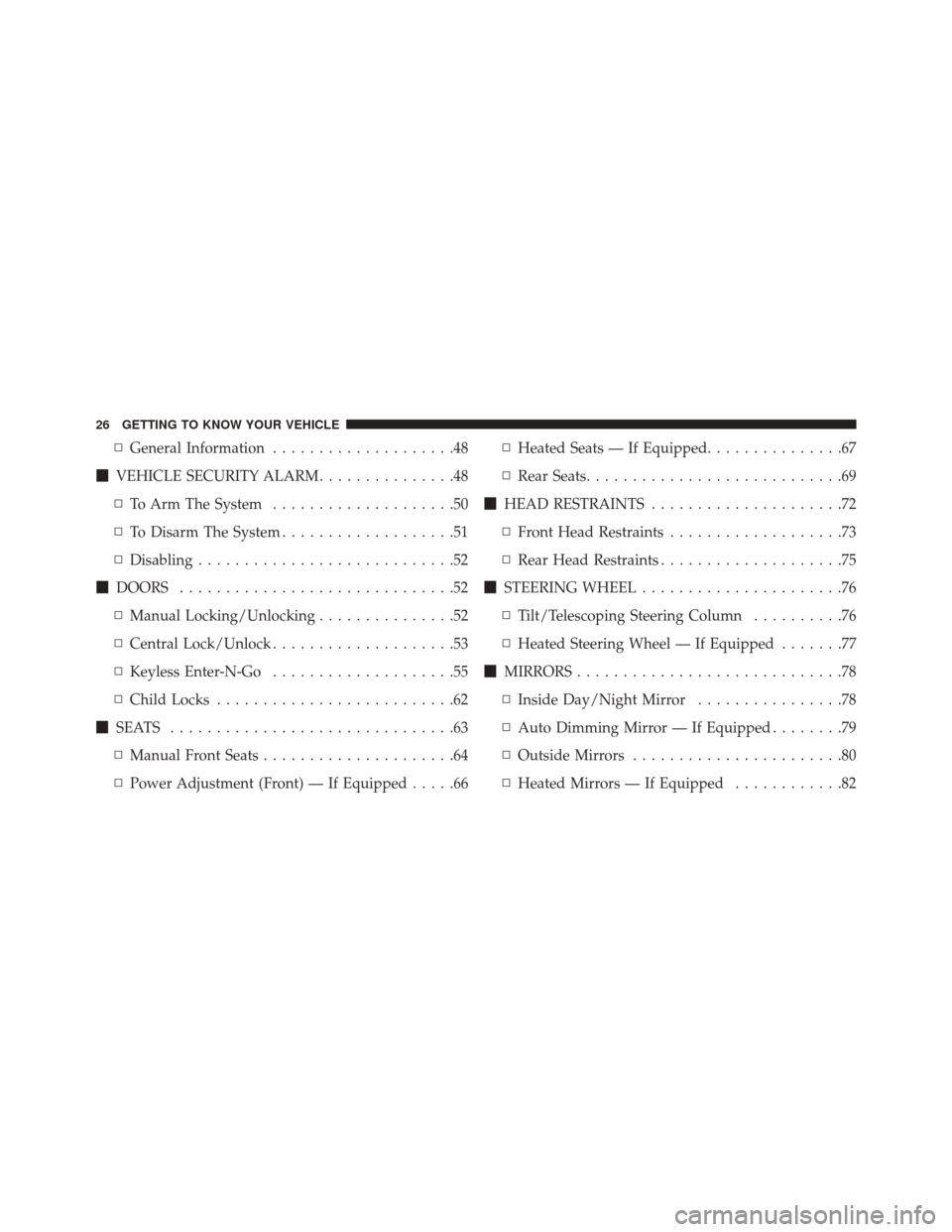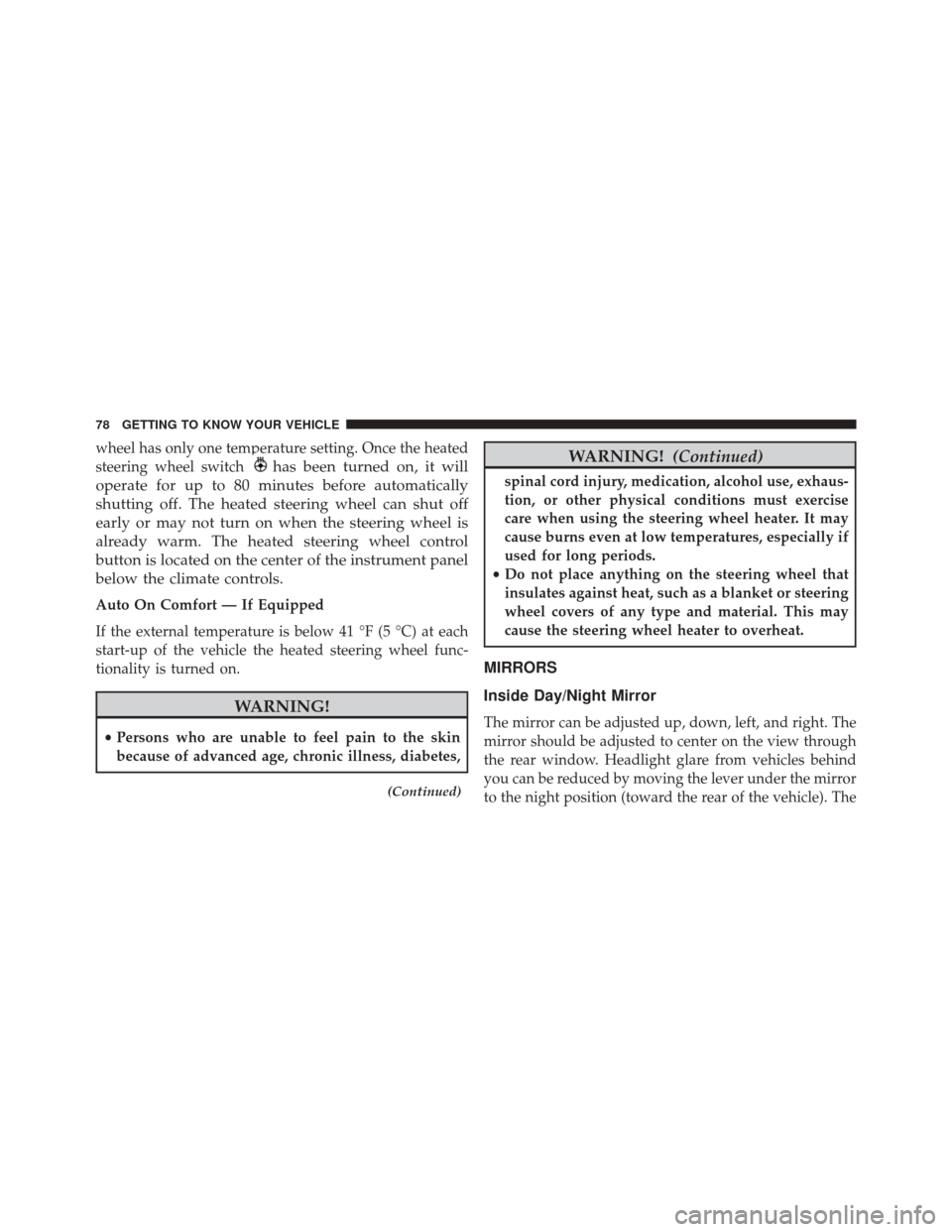Page 22 of 587
FRONT VIEW
Front View
1 — Engine Compartment
2 — Headlights
3 — Windshield4 — Outside Mirrors
5 — Doors
6 — Wheels
20 GRAPHICAL TABLE OF CONTENTS
Page 28 of 587

▫General Information ....................48
� VEHICLE SECURITY ALARM ...............48
▫ To Arm The System ....................50
▫ To Disarm The System ...................51
▫ Disabling ............................52
� DOORS ..............................52
▫ Manual Locking/Unlocking ...............52
▫ Central Lock/Unlock ....................53
▫ Keyless Enter-N-Go ....................55
▫ Child Locks ..........................62
� SEATS ...............................63
▫ Manual Front Seats .....................64
▫ Power Adjustment (Front) — If Equipped .....66▫
Heated Seats — If Equipped ...............67
▫ Rear Seats ............................69
� HEAD RESTRAINTS .....................72
▫ Front Head Restraints ...................73
▫ Rear Head Restraints ....................75
� STEERING WHEEL ......................76
▫ Tilt/Telescoping Steering Column ..........76
▫ Heated Steering Wheel — If Equipped .......77
� MIRRORS .............................78
▫ Inside Day/Night Mirror ................78
▫ Auto Dimming Mirror — If Equipped ........79
▫ Outside Mirrors .......................80
▫ Heated Mirrors — If Equipped ............82
26 GETTING TO KNOW YOUR VEHICLE
Page 80 of 587

wheel has only one temperature setting. Once the heated
steering wheel switch
has been turned on, it will
operate for up to 80 minutes before automatically
shutting off. The heated steering wheel can shut off
early or may not turn on when the steering wheel is
already warm. The heated steering wheel control
button is located on the center of the instrument panel
below the climate controls.
Auto On Comfort — If Equipped
If the external temperature is below 41 °F (5 °C) at each
start-up of the vehicle the heated steering wheel func-
tionality is turned on.
WARNING!
• Persons who are unable to feel pain to the skin
because of advanced age, chronic illness, diabetes,
(Continued)
WARNING! (Continued)
spinal cord injury, medication, alcohol use, exhaus-
tion, or other physical conditions must exercise
care when using the steering wheel heater. It may
cause burns even at low temperatures, especially if
used for long periods.
• Do not place anything on the steering wheel that
insulates against heat, such as a blanket or steering
wheel covers of any type and material. This may
cause the steering wheel heater to overheat.
MIRRORS
Inside Day/Night Mirror
The mirror can be adjusted up, down, left, and right. The
mirror should be adjusted to center on the view through
the rear window. Headlight glare from vehicles behind
you can be reduced by moving the lever under the mirror
to the night position (toward the rear of the vehicle). The
78 GETTING TO KNOW YOUR VEHICLE
Page 81 of 587
mirror should be adjusted while the lever under the
mirror is set in the day position (toward the windshield).
NOTE:The mirror will automatically release in the event
of heavy contact with a passenger.Auto Dimming Mirror — If Equipped
This mirror automatically adjusts for headlight glare
from vehicles behind you. You can turn the feature on or
off by pushing the button at the base of the mirror. A light
to the left of the button will illuminate to indicate when
the dimming feature is activated. The sensor to the right
of the button does not illuminate.
Mirror Lever
4
GETTING TO KNOW YOUR VEHICLE 79
Page 82 of 587
NOTE:This feature is disabled when the vehicle is
moving in reverse.
Outside Mirrors
Power Adjustment Mirrors
The power mirror switch is located on the drivers door
panel.
To adjust the mirror, push the mirror adjustment switch
in the four directions indicated by arrows.
NOTE:
• To adjust the power mirrors, the ignition must be in
the MAR/RUN position.
• Once the mirror is adjusted, rotate the control to the
neutral position to avoid accidental movements.
Dimming Mirror
80 GETTING TO KNOW YOUR VEHICLE
Page 83 of 587
Folding Mirror
The exterior mirrors are hinged to allow the mirror to
pivot forward or rearward to help avoid damage. The
mirror has three detent positions: full forward, normal
and full rearward.
Power Mirror Switch
1 — Mirror Adjustment Switch
2 — Mirror Selector Switch
Folding Exterior Mirror
4
GETTING TO KNOW YOUR VEHICLE 81
Page 84 of 587
Heated Mirrors — If Equipped
These mirrors are heated to melt frost or ice. This
feature can be activated whenever you turn on the
Rear Window Defroster.
BLIND SPOT MONITORING (BSM) — IF
EQUIPPED
The Blind Spot Monitoring (BSM) system uses two radar-
based sensors, located inside the rear bumper fascia, to
detect highway licensable vehicles (automobiles, trucks,
motorcycles, etc.) that enter the blind spot zones from the
rear/front/side of the vehicle. When the vehicle is started, the BSM warning light will
momentarily illuminate in both outside rear view mirrors
to let the driver know that the system is operational. The
BSM system sensors operate when the vehicle is in any
forward gear or REVERSE and enters stand-by mode
when the vehicle is in PARK.
Rear Detection Zones
82 GETTING TO KNOW YOUR VEHICLE
Page 85 of 587

The BSM detection zone covers approximately one lane
width on both sides of the vehicle, 10 ft (3 m). The zone
length starts at the outside mirror and extends approxi-
mately 20 ft (6 m) beyond the rear bumper of the vehicle.
The BSM system monitors the detection zones on both
sides of the vehicle when the vehicle speed reaches
approximately 6 mph (10 km/h) or higher and will alert
the driver of vehicles in these areas.
NOTE:
•The BSM system does NOT alert the driver about
rapidly approaching vehicles that are outside the de-
tection zones.
• If a trailer is connected to the vehicle, it is necessary to
deactivate BSM system manually by settings menu to
avoid a miss-detection. Refer to “Uconnect Settings” in
“Multimedia” for further information. The area on the rear fascia where the radar sensors are
located must remain free of snow, ice, and dirt/road
contamination so that the BSM system can function
properly. Do not block the radar sensors located on the
rear fascia with foreign objects (bumper stickers, bicycle
racks, etc.).
Rear Sensor Locations
4
GETTING TO KNOW YOUR VEHICLE 83